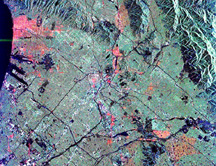Radar image of the Los Angeles Basin
Click on image for full size
Image courtesy of NASA
Los Angeles Heading for the Hills
News story originally written on October 28, 1998
Scientists have found that Los Angeles appears to be moving toward the
San Gabriel Mountains at about one-fifth of an inch per year.
The measurements were taken using the Southern California Integrated
Global Positioning System Network (SCIGN). SCIGN is a nework of 24 GPS
satellites that can detect tiny movements in earthquake
faults across Southern
California. The satellites can pinpoint the locations of ground stations
withing 0.4 inches. There are currently about 60 ground stations in the
greater Los Angeles area; the goal for the project is to have 250
stations operating continuously.
The project is designed to monitor the slow, small movements in the ground
around Southern California. By knowing where the ground is moving,
scientists can tell which areas have higher stresses and where
earthquakes are more likely to happen.
Last modified February 26, 2007 by Lisa Gardiner.
You might also be interested in:

It was another exciting and frustrating year for the space science program. It seemed that every step forward led to one backwards. Either way, NASA led the way to a great century of discovery. Unfortunately,
...more
The Space Shuttle Discovery lifted off from Kennedy Space Center on October 29th at 2:19 p.m. EST. The weather was great as Discovery took 8 1/2 minutes to reach orbit. This was the United States' 123rd
...more
A moon was discovered orbiting the asteroid, Eugenia. This is only the second time in history that a satellite has been seen circling an asteroid. A special mirror allowed scientists to find the moon
...more
Will Russia ever put the service module for the International Space Station in space? NASA officials want an answer from the Russian government. The necessary service module is currently waiting to be
...more
A coronal mass ejection (CME) happened on the Sun early last month. The material that was thrown out from this explosion passed the ACE spacecraft. The SWICS instrument on ACE has produced a new and very
...more
J.S. Maini of the Canadian Forest Service called forests the "heart and lungs of the world." This is because forests filter air and water pollution, absorb carbon dioxide, release oxygen, and maintain
...more
In late April through mid-May 2002, all five naked-eye planets are visible at the same time in the night sky! This is includes Mercury which is generally very hard to see. You won't want to miss this!
...more















